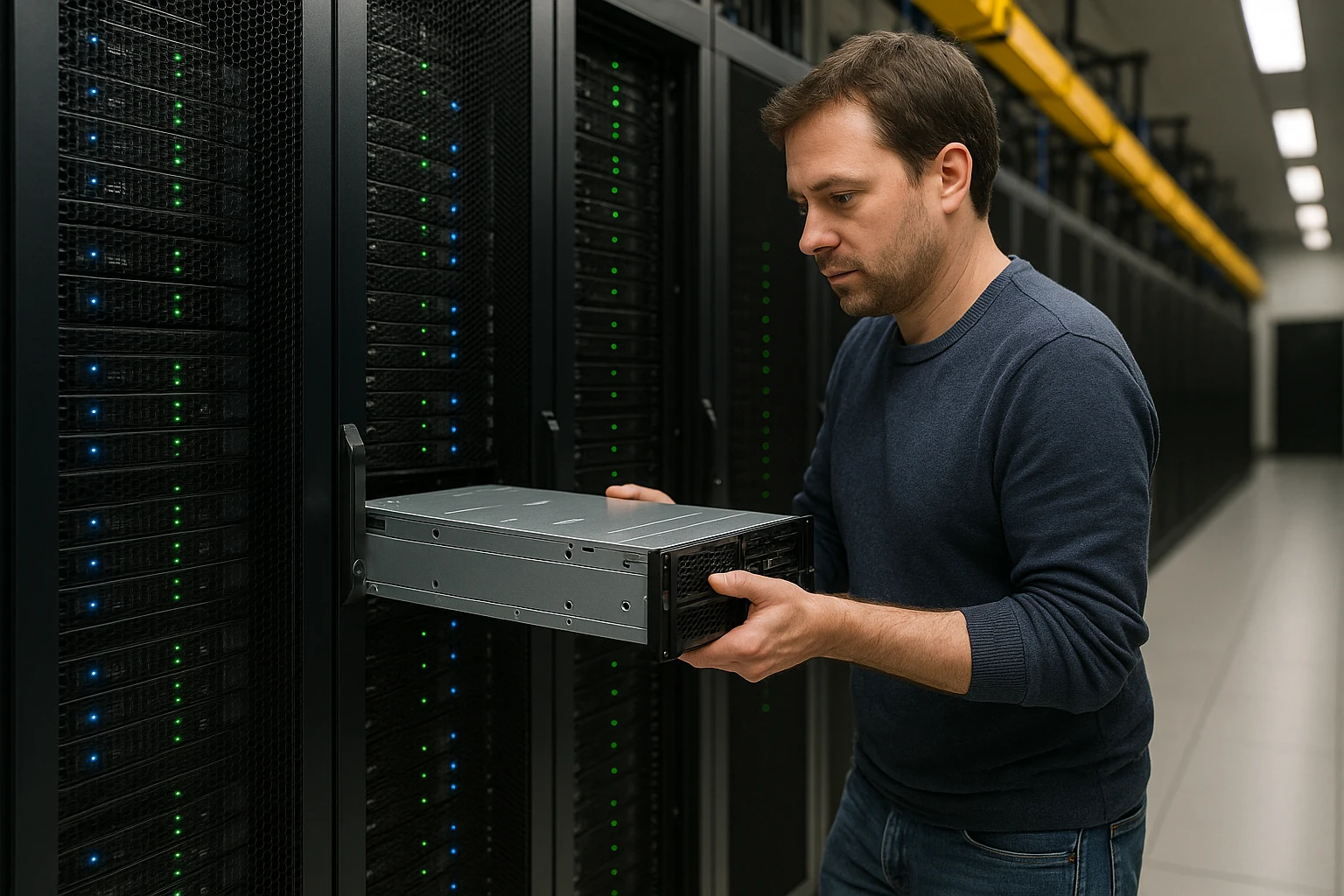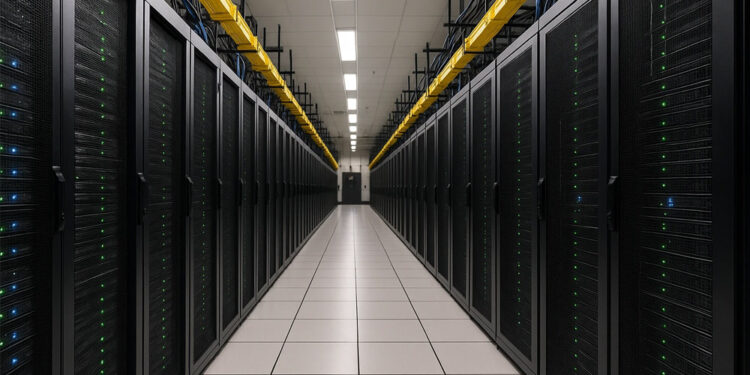Colocation hosting is one of the key approaches to organizing corporate IT infrastructure, where a company places its own servers in a professional data center operated by a provider. Instead of maintaining an in-house server room and ensuring power supply, cooling, connectivity, and security, a business rents space in a specialized data center (DC).
This approach allows companies to take advantage of professional-grade infrastructure without investing in the construction and maintenance of their own data center. Colocation is especially popular among businesses that prioritize reliability, uptime, scalability, and physical control over their equipment.
What Is Colocation Hosting
The term colocation (from co-location — “shared location”) refers to the practice of placing a client’s server equipment within a provider’s facility. The equipment remains owned by the company, while the data center supplies space, power, cooling, network infrastructure, and physical security.
Unlike dedicated hosting, where the client uses hardware owned by the provider, colocation means that the company installs its own servers inside the provider’s racks. The provider is responsible for the physical environment, while the client manages software and system administration.
Colocation can take several forms:
- Single server placement (from 1U to several rack units);
- Full rack colocation — renting an entire rack;
- Cage colocation — a dedicated, secured area for large enterprises with stricter security requirements.
In essence, colocation is a hybrid model that combines the advantages of owning your own hardware with the benefits of professional data center infrastructure.
How Colocation Works: Basic Principles
Colocation is based on a shared responsibility model between the client and the data center provider. The client installs their own servers, storage systems, routers, and other hardware in the data center, while the provider ensures all external conditions required for stable operation.
1. Equipment Placement
Client equipment is mounted in racks, each designed for a specific number of rack units (U). Depending on the agreement, a company can rent a single slot, half a rack, a full rack, or an isolated section. Modern data centers typically use standardized 19-inch racks with heights ranging from 42U to 48U, allowing dozens of servers to be housed within a single cabinet.
2. Power Supply and Redundancy
The data center supplies servers with stable, redundant power. Each rack is connected to multiple independent power sources. To prevent downtime, the following systems are used:
- UPS (Uninterruptible Power Supply) — compensates for short-term outages instantly;
- Diesel generators — keep the facility operational during prolonged power failures;
- Dual power feeds (A+B) — the standard for Tier III–IV data centers, ensuring redundancy for every circuit.
3. Cooling Systems
Server equipment generates substantial heat, so maintaining stable temperature is critical. Data centers use various cooling configurations: cold and hot aisle layouts, liquid cooling loops, and precision air conditioning systems. The air temperature is typically maintained between 18–27°C, with relative humidity kept around 40–60% to ensure optimal equipment performance and longevity.
4. Network Connectivity
The provider offers access to high-speed internet connections, often through multiple carriers to ensure redundancy and load balancing. Most data centers maintain direct connections to Internet Exchange (IX) points, guaranteeing low latency and high bandwidth capacity for all colocated clients.
5. Security and Access Control
Physical security is a core element of colocation. The data center provides:
- 24/7 controlled access (via keycards, biometric systems, or keys);
- Video surveillance across all zones;
- On-site security personnel and alarm systems;
- Detailed access logs and visitor records.
In some cases, clients may be granted permanent access to their racks or can request on-site engineers from the provider to perform maintenance tasks.
Key Components of Colocation Infrastructure
To ensure uninterrupted server operation for clients, colocation data centers are built according to strict reliability and security standards. At the core of every colocation facility lies a complex system of engineering subsystems, each playing a crucial role in maintaining stability and uptime.
1. Power Infrastructure
The foundation of colocation reliability is a robust power system. Data centers typically feature multiple independent feeds from the city grid, backup UPS systems, and diesel generators. High-density racks are equipped with dual power feeds (A+B), meaning each server is connected to two separate circuits — eliminating any single point of failure.
A typical power system includes:
- Automatic transfer switches (ATS) for seamless switching between power sources;
- Power Distribution Units (PDUs) with consumption monitoring;
- Grounding and lightning protection systems.
Reliable data centers are designed according to TIA-942 and Uptime Institute Tier III–IV standards, which guarantee uptime levels between 99.982% and 99.995%.
2. Cooling Systems
Cooling is critical for high-density server environments. Modern data centers employ a combination of technologies:
- Precision air conditioners — maintain stable temperature and humidity levels;
- Hot and cold aisle containment — separates airflows to prevent recirculation;
- Liquid cooling — used for racks with power densities of 20 kW and above.
Efficient cooling not only extends hardware lifespan but also reduces energy consumption, improving the PUE (Power Usage Effectiveness) metric.
3. Network Infrastructure
Colocation providers offer connectivity through multiple telecom carriers and direct links to Internet Exchange (IX) points. This ensures low latency, redundancy, and load balancing capabilities.
Clients typically receive:
- Dedicated bandwidth (1 Gbps, 10 Gbps, or higher);
- BGP routing for fault tolerance and traffic control;
- Private interconnections between racks or between the data center and corporate offices.
The presence of multiple carriers within one facility ensures that even if one provider fails, network connectivity remains uninterrupted.
4. Security Systems
Security in colocation operates on two levels — physical and logical.
- Physical security includes access control, video surveillance, on-site security personnel, and isolated client zones.
- Logical security involves network firewalls, intrusion detection systems, DDoS protection, and continuous monitoring.
Reliable data centers comply with international standards such as ISO 27001 (information security) and ISO 22301 (business continuity).
5. Technical Support and Maintenance
Most colocation providers offer remote hands — on-site technical assistance by engineers who can perform basic tasks such as server reboots, disk replacement, cable checks, or console access. This service is particularly valuable when equipment is located in another city or country.
Advantages of Colocation Compared to Other Hosting Models

Colocation occupies a middle ground between on-premise infrastructure (fully hosted and managed in-house) and cloud hosting (where resources are virtualized and owned by the provider). This model combines full hardware control with the benefits of a professional, high-availability data center environment.
1. Reliability and Uptime
The primary advantage of colocation is its exceptional reliability. Data centers are designed according to Tier III or Tier IV international standards, ensuring uptime levels of up to 99.995%. This is achieved through redundant power feeds, backup cooling systems, and multiple network connections. Unlike in-house server rooms, where power interruptions or cooling failures can lead to downtime, colocation facilities guarantee continuous operation even during external power or network outages.
2. Cost Efficiency
Building and maintaining a private data center requires significant investment — from construction and power infrastructure to security, cooling, and connectivity. With colocation, these costs are absorbed by the provider, while the client pays only for rack space and power consumption. Operational expenses such as maintenance, equipment repairs, and staffing are also much lower compared to running an on-premise facility.
3. Full Control Over Hardware
Unlike cloud services, where resources are virtualized and not owned by the client, colocation allows companies to use their own physical hardware. This is essential for organizations that must adhere to corporate security, licensing, or regulatory requirements. Clients can freely choose the server brand, configuration, and specifications, install any operating system, and manage software according to internal policies.
4. Flexibility and Scalability
Colocation can be easily scaled — companies can add new servers, rent additional rack units, or even expand to a full rack or cage. Unlike in-house setups, this expansion doesn’t require facility upgrades or additional cooling systems. Most providers offer flexible terms, from single-server placements to dedicated cages, making colocation suitable for businesses of all sizes — from startups to large enterprises.
5. Data Security
Colocation facilities feature advanced physical security, including on-site guards, video surveillance, access control systems, and fire suppression. This level of protection is difficult to achieve in a standard office environment. Additionally, data centers are certified under ISO 27001 and PCI DSS, ensuring compliance with strict security standards for handling personal and financial data.
6. Lower Latency and Higher Performance
Colocation enables businesses to place servers physically closer to users or critical systems. With direct access to major Internet Exchange (IX) points, latency is reduced and connection stability is improved — an essential factor for SaaS providers, gaming platforms, and financial services.
Pricing and Key Factors Affecting Colocation Costs
Colocation is a service whose cost depends on a range of technical and infrastructural parameters. Unlike cloud hosting, where clients pay for virtual computing resources, colocation pricing is determined primarily by physical factors — space occupied, power consumption, network connectivity, and data center reliability level.
1. Amount of Rented Space
The fundamental cost factor is the number of rack units (U) used by the client’s equipment. Some businesses rent a few rack spaces for individual servers, while others lease an entire rack (42U or 48U), and large enterprises may require private cages — isolated, secure areas.
Pricing scales with both space and configuration type:
- Single server (1–4U) — entry-level cost;
- Half rack (20–22U) — mid-range option;
- Full rack or cage — premium tier, but more cost-effective for high-density setups.
2. Power Consumption
Every server consumes power, and electricity is one of the largest components of colocation expenses. On average, data centers charge based on allocated capacity — typically €300 to €1,000 per kilowatt per month, depending on the facility’s tier and geographic region.
This fee usually includes:
- A+B redundant power feeds;
- Uninterruptible Power Supply (UPS) systems;
- Diesel generators for backup;
- Energy monitoring tools for usage tracking.
3. Network Connectivity and Bandwidth
Internet connectivity is billed separately and depends on:
- Required bandwidth capacity (1 Gbps, 10 Gbps, or higher);
- Traffic volume transferred;
- Number of redundant carriers involved.
Many providers offer flexible pricing models — either flat-rate bandwidth or usage-based billing.
4. Data Center Reliability Level
The cost of colocation also depends on the Tier level of the data center, which reflects redundancy and fault tolerance:
- Tier II — basic reliability (99.7% uptime);
- Tier III — enterprise-grade standard (99.982% uptime);
- Tier IV — maximum fault tolerance (99.995% uptime).
Higher-tier facilities come with higher operational costs but dramatically reduce the risk of downtime and data loss.
5. Additional Services
Colocation plans may include optional features such as:
- Remote hands — on-site engineers assisting with installation, reboots, or diagnostics;
- Monitoring and environmental reporting (temperature and power usage);
- Data backup and DDoS protection;
- Segmented VLANs for network security.
While these services increase the total cost, they significantly enhance resilience and operational efficiency.
6. Location and Data Center Class
Data centers located in financial or technology hubs (e.g., Frankfurt, Amsterdam, Paris) typically have higher pricing due to real estate, energy, and operational costs. However, proximity to major Internet Exchange (IX) points ensures superior connectivity, lower latency, and higher network reliability — often justifying the additional expense.
Why Colocation Remains the Optimal Choice
Colocation hosting combines full control over your own equipment with the reliability and scalability of professional data center infrastructure.
Unlike cloud solutions, where resources are owned and managed by the provider, colocation allows companies to operate their own servers, maintaining complete control over configuration, security, and data management. At the same time, the organization benefits from guaranteed power, cooling, connectivity, and protection that meet Tier III or Tier IV standards — levels of reliability rarely achievable in typical office environments.
The core principle of colocation is simple: your hardware, our infrastructure. The provider delivers all the necessary conditions for stable operation, while the client retains full control over the servers, software, and overall system administration.













